Garage doors may seem like a strictly practical part of your home, but they can play a big role in your overall curb appeal. With the right design choices, your garage door can become a focal point on your property or help to complement your landscape and surroundings. In our guide, we explore various garage door styles, materials, and design elements that can transform your garage from mundane to magnificent.
Carriage-House Garage Doors
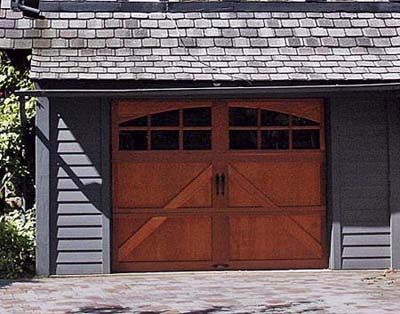
Barn-red carriage-house-style doors offer contrast against cool gray weatherboard siding and slate roofs. These narrow tongue-and-groove doors feature traditional “Z” braces and arched, six-light windows. While they appear to be two swinging doors with wrought-iron bean handles, they’re actually overhead doors, as indicated by the third handle on the bottom stile.
Formal Garage Doors
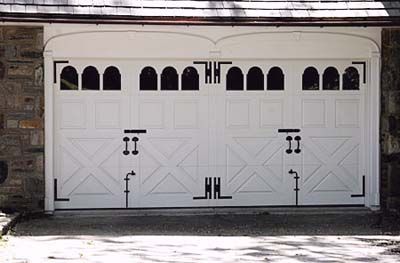
A standard two-car opening can be elevated with doors designed to resemble two sets of carriage-house swinging doors. Raised panel doors with wrought-iron corner braces and fleur-de-lis handles create an elegant look, and adding arched triple lights makes it even more visually appealing. Framing the doors with curved molding and pilasters adds a touch of formality, transforming a utilitarian space into an architectural feature.
Neutral Garage Doors
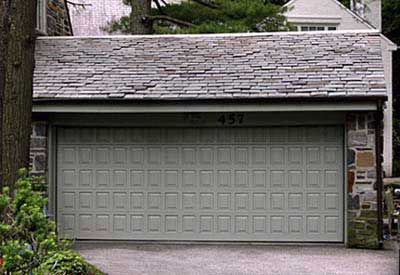
Sometimes, the key to garage door design is subtlety. A mossy green can make a long expanse of garage door recede, allowing it to blend seamlessly with surrounding stone walls. Raised panels add depth and texture, creating a soothing complement to stone facades and earth-toned color schemes. This style is particularly effective for larger garage doors, as it prevents them from overwhelming your home’s exterior.
Repurposed Garage Doors
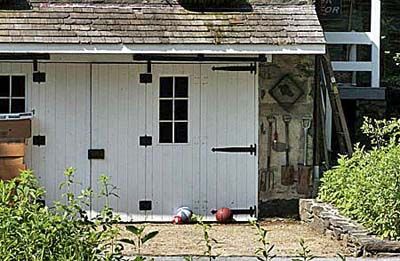
Repurposing a garage into a garden shed offers an opportunity for creative door design. Replacing a traditional overhead door with two sets of swinging vertical-board doors can completely transform the space. Adding a six-light window and wrought-iron strap hinges to one set of doors enhances the rustic, garden-friendly aesthetic.
Country Cottage Garage Doors
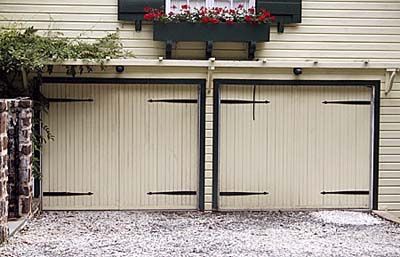
Creating the illusion of old stable doors adds a touch of country charm to your garage. Four sets of symmetrical iron strap hinges on tongue-and-groove bead board give the appearance of doors that swing open. In reality, these doors slide up and down to accommodate vehicles. The addition of a flowering vine climbing a rustic pergola completes the countryside look, blending the garage with its natural surroundings.
Accessorized Garage Doors
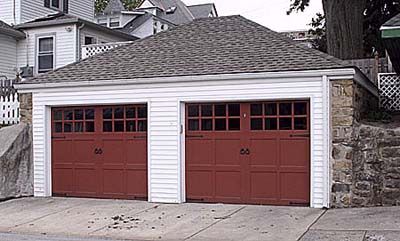
Dress up a pair of red overhead doors to evoke the charm of twin bays in an old carriage house. Two sets of four-over-four lights emphasize symmetry, while the traditional stile-and-rail pattern is enhanced by wrought-iron strap hinges and round door pulls. These hardware elements add visual interest and contribute to the door’s authentic, historical appearance.
Optical Illusion Garage Doors
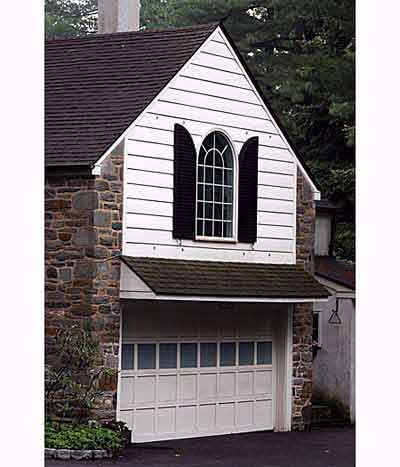
Architectural elements can be used to draw attention away from a simple garage door. A peaked gable roof and Palladian window naturally draw the eye upward, making the garage door less prominent. The door itself features a traditional stile-and-rail pattern with a middle window. The mix of geometric shapes—triangular gable, rectangular clapboards, arched window and shutters, square door panels and windows—creates an interesting contrast with the organic feel of stone walls and slate-roof overhangs.
Decorative Garage Doors
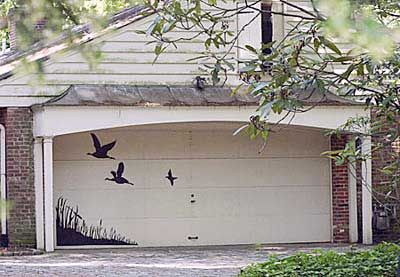
Even older, flush-style garage doors can be given new life with creative additions. A four-column copper-topped canopy can transform a simple door into a Victorian-inspired entryway. Adding painted or cast-iron silhouettes, such as marsh grass and pheasants in flight, give whimsical touches that add dimension. These elements enhance the door’s appearance and help tie it into the surrounding landscape.
Understated Garage Doors
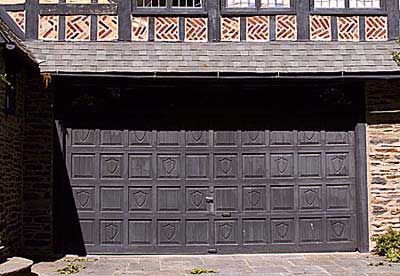
A double-width stile-and-rail pattern garage door painted black doesn’t immediately draw attention to itself. However, closer inspection reveals shield patterns carved into every other panel, providing an additional textural element. This subtle detail complements a Tudor-style façade that already incorporates stone, slate, and mosaic tile, adding depth without overwhelming the overall design. The door’s understated elegance makes it a perfect fit for homes with a historic or refined architectural style.
Practical Garage Doors
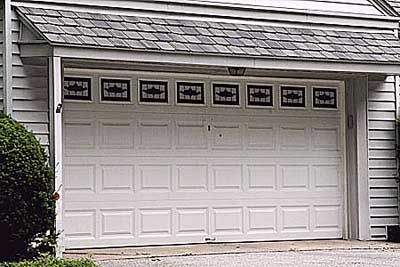
Glazed with grilles over raised panels, a slate-tile overdoor is one of the most prevalent overhead styles in America. This classic design provides a timeless look while offering functional benefits like durability.
Triple Garage Doors
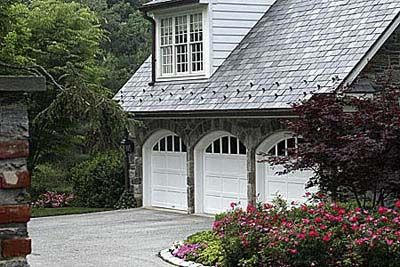
For homes with larger garages, consistency in design is key. When multiplied, carriage-house-style doors can create a visual impact. Arched doors with six-light windows add Victorian charm to a triple garage. The addition of chamfered jambs provides a polished finishing touch to these overhead doors, elevating the façade and creating a cohesive look.
Botanical Garage Doors
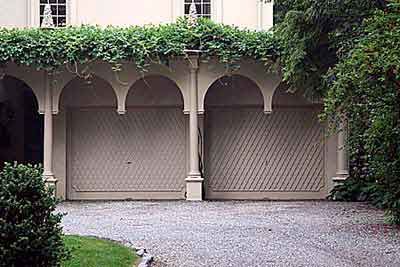
Incorporating natural elements can soften garage doors’ appearance and help them blend into the landscape. Wisteria growing on an overhead arbor serves as a natural valence, complementing the elliptical arches that frame the two doors. The raised jacquard pattern on the doors and silver topiary finials on the columns add a formal touch, blending nature and architecture.
Architectural Garage Doors
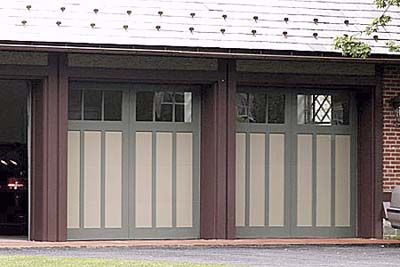
Color can play a crucial role in garage door design, especially when working with distinctive architectural styles. In a Tudor-style home, often referred to as a black-and-white house due to its exposed timber framework and white stucco-covered brickwork, painting the half-timbered panels in warm colors like yellow and green can add depth and interest. Four six-light windows across the top give natural light while maintaining privacy, creating a balanced and functional design.
Our Conclusion
Your garage doors are an opportunity to enhance your home’s curb appeal and reflect your personal style. From rustic barn-inspired designs to elegant carriage house doors, the options are vast. By considering elements such as color, hardware, windows, and surrounding landscaping, you can transform your garage door from a purely functional feature into an architectural statement.
